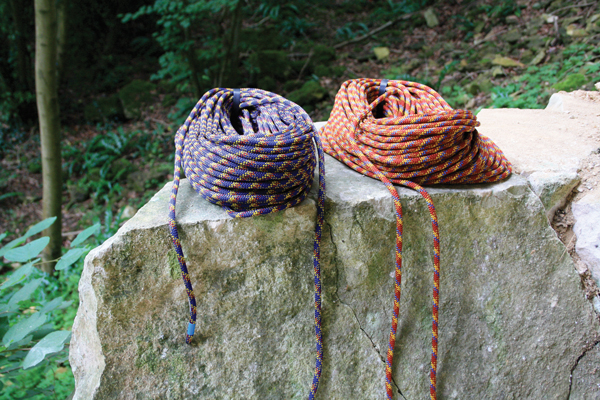IFMGA Guide Alun Richardson runs through the different types of ropes available and what they are best suited for…
The increasing popularity and diversification of climbing has led to a broader selection of climbing ropes, each with its own characteristics. This choice undoubtedly has benefits, but it can make it difficult to decipher what’s on offer and how it relates to your climbing. I have ropes for Indoor, alpine, sport and traditional climbing and I also have short lengths for specific routes and walking. I also have static ropes (non stretchy), dedicated to abseiling or ascending. To help you make your choice, we’ll look at ropes’ important characteristics and what they mean.
DIAMETER AND WEIGHT
Ropes are categorised by diameter and weight, as follows: 8.9–11mm single rope (52-77 g/m), 8–9mm half ropes (41-53 g/m) and 7–8mm twin ropes (37-42 g/m). The thicker the rope the heavier it is, the more durable it will be and the greater the friction created through a belay device, making it easier to hold a fall. Unless you are a ‘cutting edge’ climber or want to reduce the weight you are carrying, don’t worry too much about weight – you won’t fail on routes because of the weight of rope behind you.
LENGTH
The ‘standard’ length of rope is 50m and if you are buying one rope to do everything it is probably a good length to go for. If you are sport climbing then 60m or even 70m will be more useful for lowering off. 50m is fine for alpine climbing, but a lightweight 60m may be better. A pair of 60m half ropes is best for traditional rock and ice climbing. A short 30m ‘walkers’ rope is carried to overcome short rocky steps in descent.
TYPES OF ROPE
Durable single ropes (10.1-11mm): These can take abuse and when combined with a thick sheath, will give the best sharp-edge protection. They are used for big walls, top roping, working sport routes, and extreme use. Disadvantages are they are heavy and big.
All-round single ropes (9.5-10mm): Advantages are they have average diameter, not too light, nor too heavy. Used for sport, trad, alpine and winter. No disadvantages unless you are climbing fast and light or big walling.
Thin single ropes (8.9-9.4mm): These are lightweight and thin but not so durable. Used for fast-and-light in the Alps, for on-sights and hard sport climbing at your limit. Their disadvantage is that there’s more risk of rope cutting over an edge, and holding a fall is more difficult.
Half ropes (8-9mm): Designed to be used together to limit rope drag and fall potential by clipping alternately into gear. Advantages are there’s two strands to cut and you can do longer abseils. Used for rock, ice or mixed, wandering traditional or multi-pitch routes that you may need to abseil from. Disadvantages are there’s extra weight and bulk of two ropes, and they’re more complex to use and belay with.
Twin ropes (7-8mm): Lighter and less bulky than half ropes. You must clip both strands through each piece of protection. Used for non-wandering ice and rock climbs where abseiling is needed. disadvantages are there’s more rope drag than with half ropes, and they are easier to cut over an edge
DRY COATING
‘Dry treated ‘ ropes are better because wet ropes are less dynamic, abrade more easily, stretch more, and when frozen are up to 40% weaker. Make sure the dry treatment is in the core as well as the sheath.
FALL RATINGS
All ropes pass a UIAA minimum number of five laboratory-simulated falls (12 for twin ropes). A higher number may indicate a more durable rope, but because the drop test doesn’t simulate real falls don’t worry about the published number of falls a rope can withstand – It is more important to look at Impact Force.
IMPACT FORCE (IF)
This is the force transmitted to the protection, climber and belayer when the rope arrests a fall. A rope with a higher IF is more durable, but a rope with a lower IF will stretch more in a fall, reducing the force transmitted to the runners which is better for traditional climbing. Thinner ropes generally have a lower IF and are easier to clip into karabiners when
lead climbing.
SHEATH SLIPPAGE
In some ropes the outer sheath can move over the inner fibres. Zero sheath slippage makes a more durable rope, but stiffer and less soft to handle. High sheath slippage makes a rope less durable, but decreases the likelihood of it cutting over a sharp edge.
ROPE CARE
A well-looked after climbing rope cannot break in a leader fall, it will only ever break if loaded over an edge or if exposed to chemicals such as acids. The problem is that a rope’s ability to hold a leader fall over a sharp edge will reduce as it ages and after many small falls. Therefore as they get older, or have taken lots of falls, reduce their exposure to sharp edges.
Check your rope visually before each and every use and wash it regularly – run it through your hands as you coil and uncoil it checking it for damage and deformities. Acids and bleaches damage nylon rope irreparably, yet petrol, diesel and oil have minimal affect at normal temperatures. Ultimately, if you don’t trust it, relegate it to top and bottom roping or abseiling where the IF is less.
TOP 5 TIPS
1. It’s critical you buy the right rope for the intended use – get advice if unsure
2. Don’t worry too much about weight
3. Check your rope before each use and wash it regularly
4. As rope gets older (or takes falls) relegate it to top/bottom roping or abseiling
5. Keep your ropes kink-free


